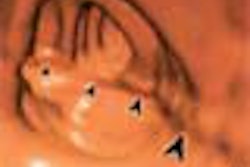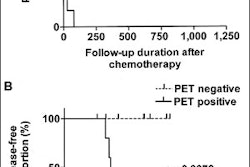CT paired with pulmonary function testing (PFT) may offer an innovative way of evaluating treatment effects in pediatric patients with cystic fibrosis (CF), according to researchers from Stanford University Medical Center in Stanford, CA. They reported their results in the Journal of Respiratory and Critical Care Medicine (September 2003, Vol. 168:5, pp. 588-593).
"We think that with this study we have developed a new outcome surrogate, which appears to be much more sensitive than any of the previous pulmonary function measurements that we’ve looked at in the past," wrote lead researcher Dr. Terry Robinson, who is from Stanford’s pediatric pulmonary division. Robinson’s co-authors are from the divisions of pediatric radiology, radiology, and biostatistics at the center.
Twenty-five children, ages 6-18 with mildly reduced pulmonary function, were enrolled in the one-year study. Patients qualified if they had a "forced vital capacity (FVC) of greater than 85%, the ability to perform forced reproducible PFT, and percent predicted FEV1 of about 70%," according to the group.
All participants received regular medical care at the CF clinic, and were randomized into either a daily dose of dornase alfa, or to normal saline aerosol. They were evaluated at three and 12 months. Outcome variables were PFT results, a global high-resolution CT, and a composite score incorporating both PFT and CT.
The most significant difference in treatment impact (observed at 12 months) was with the "composite total and maximal CT/PFT scores (35.4% and 30.4%), compared with mean forced expiratory flow during the middle half of FVC (FEF25%-75%) (13.0%) and total (6.2%) and maximal global (7.2%) HRCT scores," the researchers stated.
They concluded that the composite score, based on total HRCT scores, was at least 2.7 times more sensitive at detecting differences in percent change than any other outcome measure examined, including pulmonary function measurements, global HRCT scores, and individual HRCT component scores.
"By bringing these two modalities together we have found much more sensitivity. So in the future you may see other studies which attempt to combine different modalities, structurally based (CT), and the functional component (PFT)," Robinson said. However, the group cautioned that larger studies on children with more substantial CF lung disease were necessary.
Robinson and his team are currently developing postprocessing quantitative measurements for the CT/PFT scoring system components, such as quantitative air trapping and quantitative bronchial wall thickness.
"These are going to be important because these measures will be evaluated in the context of the pulmonary function test and quantitatively determined parameters from a CT scan, which will allow a much more rigorous composite scoring basis," Robinson stated.
By Jerry IngramAuntMinnie.com contributing writer
September 15, 2003
Related Reading
Immunomedics highlights LeukoScan research, June 26, 2003
New MRI method allows visualization of distal airways, April 29, 2003
CT, MRI helps pinpoint rare pancreatic alteration cystic fibrosis patients, March 5, 2001
Copyright © 2003 AuntMinnie.com




















